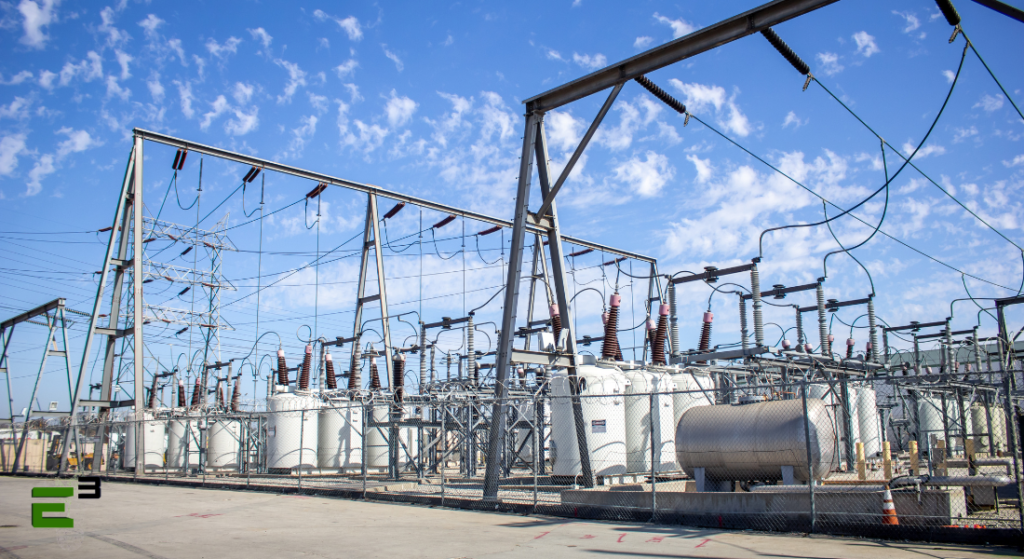Power grid” is an interconnected system that generates, transmits, and distributes electricity to end consumers.

Here is a detailed description of the main components of a power grid:
1. Energy Generation
Energy Sources: Electricity is generated in power plants using various energy sources, such as fossil fuels (coal, natural gas), nuclear energy, hydroelectric power, and renewable sources (solar, wind, biomass).
Power Plants: Power plants convert these energy sources into electricity. For example, a hydroelectric power plant uses the energy of moving water to generate electricity.
2. Energy Transmission
High-Voltage Lines: The generated electricity is transmitted over long distances through high-voltage lines. This is necessary because high-voltage transmission reduces energy loss over distances.
Transmission Substations: These substations increase (step-up transformers) or decrease (step-down transformers) the voltage of electricity to facilitate transmission and distribution.
3. Energy Distribution
Distribution Substations: Distribution substations reduce the voltage of electricity to levels that are safe for domestic and commercial use.
Distribution Lines: These lines carry electricity from distribution substations to end consumers, such as homes, businesses, and industries.
4. End Consumers
Homes, Businesses, and Industries: Electricity is finally used by end consumers for a variety of needs, including lighting, heating, cooling, and operating appliances and machines.
Energy Efficiency: Power Grids and Sustainable Practices
A power grid and energy efficiency are closely linked, as a well-designed and managed grid can significantly enhance energy efficiency. Efficient transmission and distribution systems minimize energy losses, ensuring more electricity reaches end consumers. The integration of renewable energy sources, like solar and wind, into the power grid reduces reliance on fossil fuels and promotes sustainability.
Smart grids and advanced energy management technologies further improve efficiency. They enable real-time monitoring and adjustment of energy flow, reducing waste and optimizing usage. Energy storage technologies, such as batteries, help balance supply and demand, storing excess energy for use during peak times.
Ultimately, an efficient power grid supports environmental sustainability, reduces costs, and enhances the reliability and flexibility of the energy supply. Investing in grid technologies and maintenance is crucial for maximizing energy efficiency and meeting future energy needs sustainably.
Importance of a Power Grid
A power grid is an intricate and essential system that generates, transmits, and distributes electricity to end consumers, playing a vital role in modern society. The importance of a well-functioning power grid cannot be overstated, as it ensures several key benefits:
Reliability
A robust and well-designed power grid guarantees a continuous and reliable supply of electricity. This reliability is crucial for daily life, industrial operations, and emergency services. Consistent power availability ensures that homes, businesses, and critical infrastructure operate smoothly without interruption.
Efficiency
Efficiency in the power grid is achieved through optimized processes in generation, transmission, and distribution of electricity. Efficient power grids minimize energy losses, thereby reducing operational costs and environmental impact. Advanced technologies and infrastructure improvements contribute to maintaining high efficiency levels, which, in turn, lowers electricity costs for consumers.
Sustainability
Integrating renewable energy sources into the power grid is a significant step towards environmental sustainability. Renewable sources such as solar, wind, and hydroelectric power reduce the reliance on fossil fuels, decreasing greenhouse gas emissions and mitigating climate change. A sustainable power grid supports long-term environmental goals and promotes cleaner energy production.
Flexibility
Modern power grids are designed to be flexible, allowing them to adapt to fluctuations in supply and demand. This flexibility is essential for integrating renewable energy sources, which can be intermittent. Advanced grid management systems and technologies, such as smart grids and energy storage solutions, enable the grid to respond dynamically to changing conditions and ensure a stable power supply.
Challenges
Maintaining a power grid poses several challenges.
Maintenance: Maintaining infrastructure and ensuring continuous upgrades are essential to prevent outages and ensure reliable operation.
Security: Protecting the grid against cyber and physical attacks is crucial for national security. Implementing advanced security measures and investing in resilient infrastructure are key to safeguarding the grid.
Integration of Renewable Energy: Integrating intermittent energy sources, such as solar and wind, requires advanced energy storage and management technologies. These technologies help to balance the supply and demand, ensuring that renewable energy can be effectively utilized within the grid.
The power grid is an essential infrastructure for modern life, ensuring that the electricity needed for homes, industries, and public services is supplied reliably, efficiently, and sustainably. The complexity of the system involves generating, transmitting, and distributing energy, with each stage crucial for minimizing losses and maximizing efficiency.
Integrating renewable energy sources is vital for environmental sustainability, reducing dependence on fossil fuels and greenhouse gas emissions. Additionally, the flexibility of modern grids allows them to adapt to fluctuations in energy supply and demand, ensuring a continuous supply even with the intermittency of renewable sources.
However, the challenge of maintaining and upgrading the infrastructure is ongoing. Security against cyber and physical attacks is critical, requiring investments in advanced protective and resilient measures. Furthermore, integrating renewable energy sources necessitates advanced energy storage and management technologies to balance supply and demand effectively.
The effective functioning of a power grid is fundamental to economic and social progress as well as environmental sustainability.
Investing in technology, security, and maintenance is crucial to addressing future challenges and ensuring that the electrical grid continues to meet the growing needs of society efficiently and sustainably.



